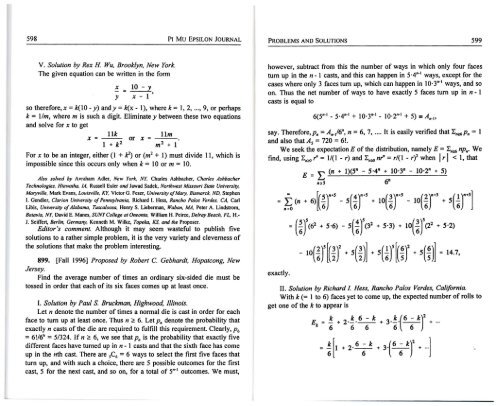Vol. 10 No 7 - Pi Mu Epsilon
Vol. 10 No 7 - Pi Mu Epsilon
Vol. 10 No 7 - Pi Mu Epsilon
Create successful ePaper yourself
Turn your PDF publications into a flip-book with our unique Google optimized e-Paper software.
598 PI MU EPSILON JOURNAL<br />
PROBLEMS AND SOLUTIONS 599<br />
V. Solution by Rex H. Wu, Brooklyn, New York.<br />
The given equation can be written in the form<br />
X _<br />
J - X -<br />
<strong>10</strong> - y<br />
1 '<br />
so therefore, x = k(<strong>10</strong>- y) andy= k(x- 1), where k = 1, 2, ..., 9, or perhaps<br />
k = lim, where m is such a digit. Eliminate y between these two equations<br />
and solve for x to get<br />
x=<br />
Ilk<br />
or x=<br />
11m<br />
1 + k 2 m 2 + 1<br />
For x to be an integer, either (1 + ,tl) or (m 2 + 1) must divide 11, which is<br />
impossible since this occurs only when k = <strong>10</strong> or m = <strong>10</strong>.<br />
Also solved by Avraham Adler, New York, NY. Charles Ashbacher, Charles Ashbacher<br />
Technologies, Hiawatha, /A, Russell Euler and Jawad Sadek, <strong>No</strong>rthwest Missouri State University,<br />
Maryville, Mark Evans, Louisville, KY, Victor G. Feser, University of Mary, Bismarck, ND, Stephen<br />
I. Gendler, Clarion University of Pennsylvania, Richard I. Hess, Rancho Palos Verdes, CA, Carl<br />
Libis, University of Alabama, Tuscaloosa, HenryS. Liebennan, Waban, MA, Peter A. Lindstrom,<br />
Batavia, NY. David E. Manes, SUNY College at Oneonta, William H. Peirce, Delray Beach, FL. H.<br />
J. Seiffert, Berlin, Germany, Kenneth M. Wilke, Topeka, KS, and the Proposer.<br />
Editor's comment. Although it may seem wasteful to publish five<br />
solutions to a rather simple problem, it is the very variety and cleverness of<br />
the solutions that make the problem interesting.<br />
899. [Fall 1996] Proposed by Robert C. Gebhardt, Hopatcong, New<br />
Jersey.<br />
Find the average number of times an ordinary six-sided die must be<br />
tossed in order that each of its six faces comes up at least once.<br />
I. Solution by PaulS. Bruckman, Highwood, Illinois.<br />
Let n denote the number of times a normal die is cast in order for each<br />
face to turn up at least once. Thus n ~ 6. Let Pn denote the probability that<br />
exactly n casts of the die are required to fulfill this requirement. Clearly, p 6<br />
= 6!/6 6 = 5/324. If n ~ 6, we see that Pn is the probability that exactly five<br />
different faces have turned up in n - 1 casts and that the sixth face has come<br />
up in the nth cast. There are 5 C 6 = 6 ways to select the first five faces that<br />
turn up, and with such a choice, there are 5 possible outcomes for the first<br />
cast, 5 for the next cast, and so on, for a total of 5n-t outcomes. We must,<br />
however, subtract from this the number of ways in which only four faces<br />
turn up in then- 1 casts, and this can happen in 5·4n-t ways, except for the<br />
cases where only 3 faces turn up, which can happen in <strong>10</strong>·3n-t ways;and so<br />
on. Thus the net number of ways to have exactly 5 faces turn up in n - 1<br />
casts is equal to<br />
say. Therefore, Pn = A,./6n, n = 6, 7, .... It is easily verified that "};~~ Pn = 1<br />
and also that A 5 = 720 = 6!.<br />
We seek the expectation E of the distribution, namely E = "J;n~ npn. We<br />
find, using Ln
















